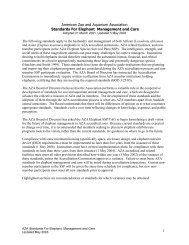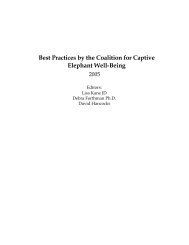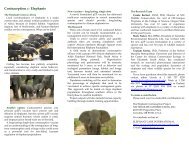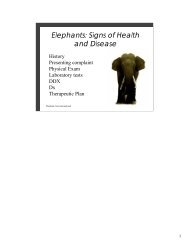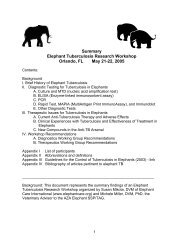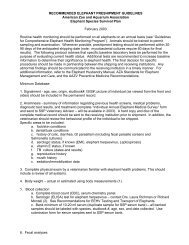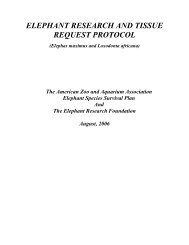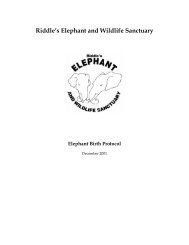Nepal Elephant TB Control and Mgt Action Plan.pdf - Elephant Care ...
Nepal Elephant TB Control and Mgt Action Plan.pdf - Elephant Care ...
Nepal Elephant TB Control and Mgt Action Plan.pdf - Elephant Care ...
- No tags were found...
You also want an ePaper? Increase the reach of your titles
YUMPU automatically turns print PDFs into web optimized ePapers that Google loves.
<strong>Nepal</strong> <strong>Elephant</strong> Tuberculosis <strong>Control</strong> <strong>and</strong>Management <strong>Action</strong> <strong>Plan</strong> (2011-2015)<strong>Nepal</strong> began in 2006. Culture <strong>and</strong> experimentalserological tests were used to screen elephantsat this me. One of these tests - the <strong>Elephant</strong><strong>TB</strong>Stat-Pak® (Chembio Diagnoscs, Inc, Medford,New York, U.S.A. www.chembio.com) wassubsequently licensed by the United StatesDepartment of Agriculture (USDA) in 2007 as ascreening test for <strong>TB</strong> in elephants.Cultures collected in 2006 <strong>and</strong> evaluated atthe Naonal Tuberculosis Instute (NTI) in<strong>Nepal</strong> <strong>and</strong> the Naonal Veterinary ServicesLaboratories (NVSL) in Ames, Iowa, U.S. provednon-diagnosc due to contaminaon, storage,<strong>and</strong> transport issues. The same problems wereencountered when elephant respiratory sampleswere submi ed to the <strong>Nepal</strong> An-TuberculosisAssociaon (NATA) in subsequent years. These<strong>and</strong> other issues, such as intermi ent shedding,limit the value of culture as a primary diagnosctechnique. In Sweden, only 7 of 189 respiratorysamples collected from 5 elephants confirmed<strong>TB</strong>-infected at postmortem were cultureposive(Moller et al. 2005). In Thail<strong>and</strong>, <strong>TB</strong> wasisolated from only 2 of 60 respiratory samplescollected from confirmed <strong>TB</strong>-infected elephants(Angkawanish et al. 2010).Culture as well as molecular diagnosctechniques such as PCR is nonetheless valuable<strong>and</strong> improving the methods to apply thesetechniques to elephants remains an importantgoal. Collaboraons have been established withthe <strong>Nepal</strong> An-tuberculosis Associaon (NATA)<strong>and</strong> the Center for Molecular Diagnoscs –<strong>Nepal</strong> (CMDN) for this purpose. In 2009-2010,these laboratories confirmed Mycobacteriumtuberculosis, the human strain of <strong>TB</strong>, as thecausave agent in three elephants in <strong>Nepal</strong>.<strong>TB</strong> can be transmi ed from humans to elephants<strong>and</strong> from elephants to humans. In 2008, over100 elephant h<strong>and</strong>lers were tested for <strong>TB</strong>, butno cases of <strong>TB</strong> were detected. <strong>TB</strong> is a longtermdisease <strong>and</strong> previous h<strong>and</strong>lers, no longeremployed may have been the source of infeconfor the three M.tb-infected elephants. Theseelephants may also have acquired <strong>TB</strong> from otherinfected elephants. It is presumed that elephantsin <strong>Nepal</strong> may also harbor the bovine strain of <strong>TB</strong>however laboratory capacity to diagnose M. bovisis limited <strong>and</strong> this has not yet been confirmed.This is an area for further research.Tuberculosis can be caused by a number ofmycobacterial species <strong>and</strong> many of these bacteriainfect mulple hosts. The recognion of <strong>TB</strong> inelephants is smulang a shi! in thinking abouthow disease is perceived. Generally zoonoses arethe concern of the public health community but<strong>TB</strong> is an anthroponosis (an infecous disease inwhich a disease causing agent carried by humansis transferred to other animals) highlighng theneed for involvement of both animal <strong>and</strong> humanhealth professionals <strong>and</strong> agencies. A furthercomplicaon in the human community has beena rise in HIV/AIDS; a disease o!en associatedwith tuberculosis which it promotes throughimmune suppression of the human host <strong>and</strong> bywhich <strong>Nepal</strong> is increasingly suffering. Therefore,a more holisc view of tuberculosis surveillance<strong>and</strong> control is needed. This requires a muchbroader, “One-Health” (Human - Livestock -Wildlife) approach which is gaining momentumin the global health community. This paradigmtakes into account the enre epidemiologyof the disease, examines all the suscepblespecies, carriers <strong>and</strong> likely drivers of infecon <strong>and</strong>epidemics. Part of this elephant <strong>TB</strong> strategy mustbe to integrate with the other health professionsconcerned with livestock <strong>and</strong> humans, bringingthe perspecve <strong>and</strong> knowledge gained from theelephant <strong>and</strong> wildlife experiences. A One Health<strong>Nepal</strong> iniave is in the conceptual stage <strong>and</strong> <strong>TB</strong>is considered a perfect example to provide proofof concept <strong>and</strong> be er management, diagnosis,control <strong>and</strong> prevenon of the disease amongstall animal species <strong>and</strong> most importantly, humanbeings.3




